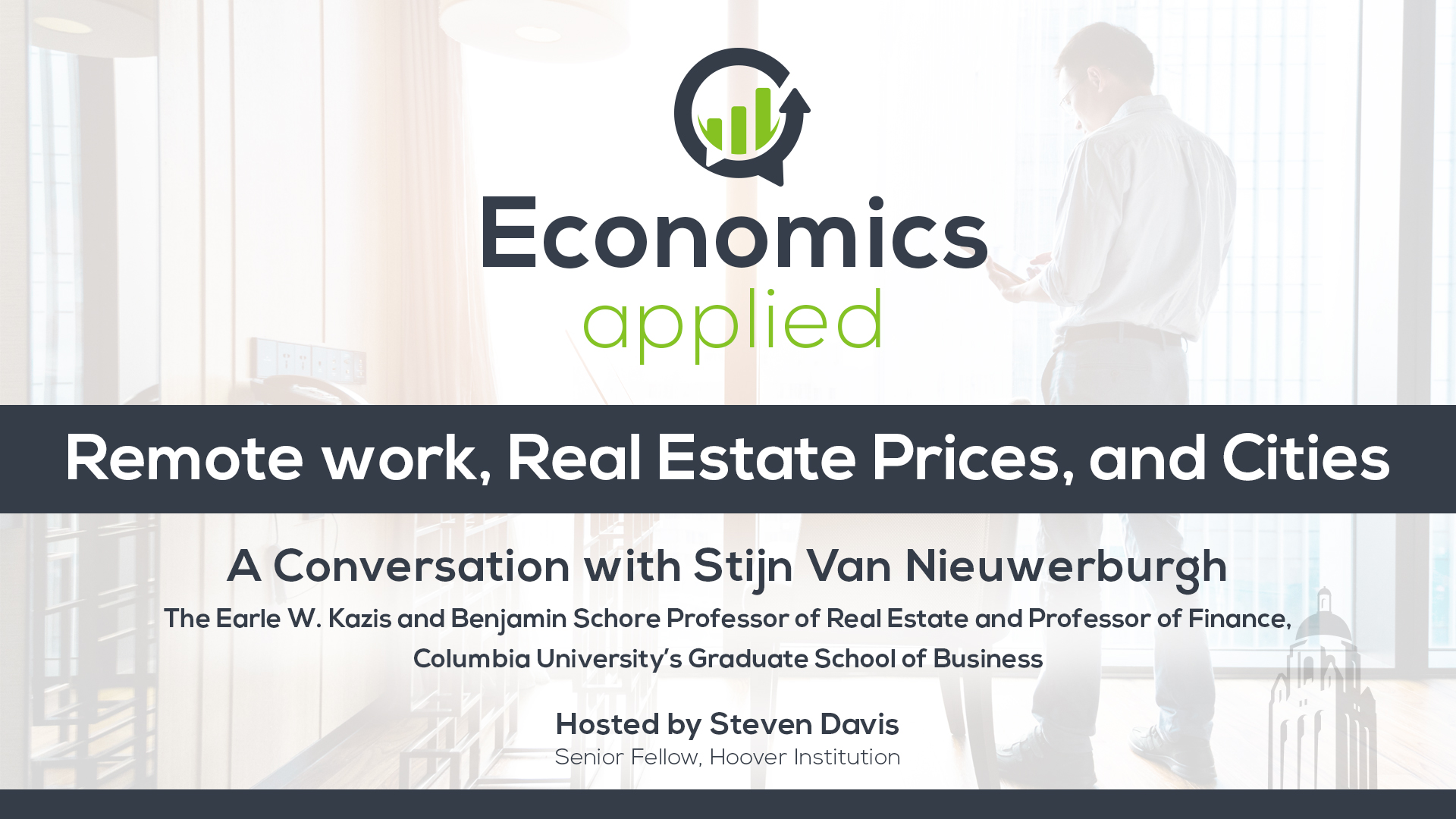Stijn Van Nieuwerburgh joins Steven Davis to explain how the remote work revolution affects urban property values, municipal tax revenues, and the outlook for cities. Stijn and Steve also consider how policymakers can respond to the challenges facing cities. In this regard, they discuss the conversion of vacant commercial buildings to new housing units, the need for regulatory reforms that lower construction costs, subsidies to real estate development, and the importance of safe, low-crime urban environments.
>> Steven Davis: Welcome to Economics Applied, a podcast produced by the Hoover Institution. My name is Steven Davis, and I host the show. Our guest today is Stane van Neuerburg. Stane is a chaired professor at Columbia Business School. He's an economist with deep expertise in real estate markets and the behavior of asset prices.
Today we will talk about some of his research on how the remote work revolution is affecting property values and cities. Welcome, Stane. It's great to have you on the show.
>> Stijn Van Nieuwerburgh: Thanks so much, Steve. Great to be here.
>> Steven Davis: Okay, in an article about your research on how remote work affects urban property values and the outlook for cities, no less than the New York Times called you a prophet of urban doom.
So that's very catchy. But my reading of your research is it would be more accurate to say that it amounts to a loud warning bell for cities, not necessarily a prophecy. Is that right?
>> Stijn Van Nieuwerburgh: That sounds better. Steve, I don't like the moniker of being a prophet of any sort of doom, but I do think that the remote work revolution has fundamentally changed the landscape.
Has fundamentally shifted the demand for office space, and that that has wide ranging repercussions for the value of these office buildings, the financial health of banks that have lent against these offices. And the fiscal health of local governments that rely crucially on the tax revenues that these office buildings are generating.
>> Steven Davis: Yeah, I tend to agree with you about that. Let's try to put some numbers around this, cuz you've made a very serious effort to do that. So what can you tell us in the way of the impact of the big shift to work from home on urban property values?
Divide it up between residential and commercial as you see fit.
>> Stijn Van Nieuwerburgh: Sure, so let's talk about office and downtown retail real estate first, because that's really ground zero of the impact of remote work on cities, right? So what we've done is we've looked at cash flows of rent revenues, basically from commercial office buildings and what has happened to those since the onset of the pandemic.
And what we found is that the existing revenue from all active leases on nationwide in the United States has fallen by about 21% since the beginning of 2000, right? That's until May of 2023, when our current data set ends. So that's a severe cash flow shock, but it's maybe not apocalyptic.
It's important, when we think about this 21% number to remember, though, that only about 30% to 40% of pre pandemic leases have actually come up for renewal, right? What that means is that there's more than half of the tenants that have not had to make active space decisions yet, they're still sitting on these long-term leases from before the pandemic.
If and when their lease comes up for renewal, if they make similar decisions than the folks whose lease has come up for renewal in these last three and a half years. We are bound to see a much further decline in the cash flows from these offices. And even at this point, we are looking at vacancy rates on offices that are an all time high.
Essentially, Steve, what's happening is everyday leases are rolling off, very few new leases are being signed, and vacancy rates are rising.
>> Steven Davis: Let me just draw this out. Make sure first I wanna understand, when you talk about what's happened to revenues, what's the population set we're talking about, are we talking about the largest cities, all US cities, all commercial and retail?
>> Stijn Van Nieuwerburgh: I'm talking about office, but I'm talking about all 105 major office markets in the United States.
>> Steven Davis: Okay.
>> Stijn Van Nieuwerburgh: That's essentially the country.
>> Steven Davis: Yeah, major cities, but there's 105 by your account. The numbers, I'll just put it a different way. What you're citing, you made the very important point about the length of these leases, implies that only a third or so have rolled off.
So we're talking about if we extrapolate to when they all have rolled over, more like at least a 50% decline.
>> Stijn Van Nieuwerburgh: That's definitely in the cards already. And already, my point is already we have seen record vacancy rates. Vacancy is an interesting statistic because it allows us to go a little bit further back in time, especially for some major markets like Manhattan or San Francisco.
>> Steven Davis: Do those vacancy statistics tell you that this one third that's already rolled off is especially concentrated in the worst performing markets or the best performing markets? Or is it just kind of reasonably representative?
>> Stijn Van Nieuwerburgh: It's reasonably representative and it's an aggregate shock. It's happening in all markets.
So vacancy rates are essentially at an all time high in pretty much every office market in the US.
>> Steven Davis: Okay, one more point I wanted to make. You talk about this decline in revenues. This is in nominal terms, right?
>> Stijn Van Nieuwerburgh: Absolutely, yes.
>> Steven Davis: So the price level has also risen by about a fifth since 2019.
So in real terms, the decline in leasing revenues is actually quite a bit larger than what you're measuring. So I think that's important for the audience to understand as well.
>> Stijn Van Nieuwerburgh: The other important point is to think about the costs, because, a lot of costs of running an office building are fixed costs in nature, right?
Basically, when the occupancy rate of your office building is 95%, you essentially get to amortize all these fixed costs over lots of different tenants. But when your occupancy rate drops from 95% to 75%, which doesn't feel like a dramatic drop, it might be enough to essentially erase all of your profit, right?
The value of your building, of course, depends on the present value of the profit stream from that building, not just the revenues, right? And that's sort of how we get to our bottom line number in our research paper, which is what has happened to the value of these office buildings.
And essentially what we're doing is we're trying to revalue the entire stock of office buildings in the country. We do it carefully for the office market of Manhattan, which is by far the largest office market in the country, and we end up concluding that the value of Manhattan office buildings has fallen by about 42% over the last two and a half.
Sorry, three and a half years since the onset of the pandemic, right? So that's a major decline in value.
>> Steven Davis: Okay, so you made an important point about shifting from revenues to profits, given the importance of fixed costs in this sector, and then you. So New York in particular.
So you gave this 42% reduction in value of office real estate in New York. New York is huge, huge market, as you pointed out. So that's worth knowing all by itself. But how does the New York office market stack up? Where does it fit in the distribution of office markets in the US overall, in terms of performance in, say, 2019, as measured by vacancies or other metrics that you think are informative?
>> Stijn Van Nieuwerburgh: That's a very important question, and I think the answer might surprise some of your listeners that the New York office market is an average office market in terms of its performance. It sits in the middle of that distribution. One of the reasons is that the New York City economy is a very well diversified economy.
It has tenants from all sorts of different sectors. Think about contrast. San Francisco, for example, is very tech dependent, right? And that sits in the right tail of that distribution in terms of how severe or in the left tail ends, in terms of how severely it's impacted.
>> Steven Davis: The bad tail.
>> Stijn Van Nieuwerburgh: The bad tail of the distribution, depending on what we're looking at.
>> Steven Davis: Right.
>> Stijn Van Nieuwerburgh: So let me make one more point about office value, which is that, again, it's sort of an important point that is a little bit sometimes overlooked, which is not all office is created equally, right?
So my statements were about the aggregate stock, the total stock of office, but there's a segment of the office market that's actually holding up reasonably well, which is the very best, the very top segment of the market. People sometimes call it class A plus or trophy buildings. These are typically newer buildings Constructed in the last few years, and they have sort of managed to attract a bunch of tenants from lower quality offices.
The story goes something like this, with a lot of workers having worked remotely, companies are struggling to attract their workers back to the office. And so they need to earn the commute of their workers. And the way they do it is they rent much nicer office space, that's better amenities.
Maybe it has pet care or childcare at the ground floor, or a restaurant, or a gym, or something like that. So they basically give up their old lease for 200,000 square feet in a class b building, and they move to a class a plus building, but they only rent half as much space, 100,000 square feet in that building.
And maybe they're paying rents that are double, what they were paying before. So their overall rent bill, doesn't change. They just have nicer office space now, but a lot less of it, which obviously is terrible news for the aggregate demand for office, but good news for the owners of these trophy buildings.
>> Steven Davis: Yeah, so, I mean, in very simple terms, if you only have half as many people commuting into the city, then in some sense you need a heck of a lot less office space. And we would expect people to concentrate in the better buildings, and abandon, some of the lowest quality building, which I guess creates problems in and of itself.
>> Stijn Van Nieuwerburgh: And indeed, that's what we're seeing, right? So basically, something like 80% of all vacancy is concentrated in something like 30% of all office buildings. And this will only accelerate in the future, because essentially, basically there will be winners and losers. The losers will essentially become vacant buildings, and something else will need to be done with these buildings.
And the very best buildings are doing well. So, what we've called is a flight to quality, in our research. But it's a bit of a misnomer because it's not like the trophy buildings are doing phenomenally well. They are doing better, but still not great. So that's sort of, I think, the nuance on the health of the office market.
>> Steven Davis: Yeah, you call it a nuance, but it also highlights the need to repurpose the use of many of the office buildings that have been negatively affected by the shift to remote work. And they are probably, the vacant buildings will be concentrated, in most cases, in certain parts of a city.
Those cities will be doing quite poorly until those spaces are repurposed and there are people who are using them again, and people walking the streets and retail shops to serve them and so on.
>> Stijn Van Nieuwerburgh: Absolutely, so that's, I think a crucial part of sort of the policy response looking forward, right?
And it's sort of closely associated with this notion of the urban doom loop. With enough vacancy, in these office buildings, there's entire parts of the city that are sort of struggling in terms of, the street life. The vibrancy of these neighborhoods, also the tax revenues that are coming in from these properties.
Property taxes is sort of one channel through which this happens. But of course, sales taxes, retail sales taxes is another one. And then, when tax revenues go down, because property values have gone down, cities have to balance their budget. So, if there's less tax revenue from commercial tax, then, typically either taxes have to go up on businesses or consumers which not a great choice for cities.
Or, government services have to be cut, which means less money for police departments, for transportation systems, for education, and so forth. All of which lower the quality of life in the city, which then leads to out migration and to further acceleration of these physical stresses.
>> Steven Davis: Now you're describing the dynamics of the doom loop, that is a possibility of playing.
Now, it's not an inevitability, at least not in most places, but there's two things that I have in my mind now. One, residential real estate values. And then I wanna come back to, something you just alluded to qualitatively, which is the impact on city level finances. So maybe we take those, talk about residential property values, and then let's go to the municipal tax revenue issue.
>> Stijn Van Nieuwerburgh: Yeah, so residential property values are very interesting because the last two years in the aggregate, for the us economy as a whole. Residential property values probably have never risen more, in a two year span than they did between, let's call it March of 2020 and March of 2022.
Nationwide, residential property went up about 40%, 40% to 45% in value, which is a massive wealth.
>> Steven Davis: This is nominal, this is nominal terms.
>> Stijn Van Nieuwerburgh: That's nominal? Of course, there's maybe also been 15% inflation over that two year period. But still, it's a massive source of wealth creation.
And there's an interesting question of why that has happened. I think remote work is actually at least part of the explanation. People just demanded more housing as a whole because they needed a home office. They wanted more space, they wanted the backyard. So, all of these things, I think, are certainly an important part of the conversation.
And there's some interesting research by other scholars that has sort of tried to quantify what part of that value increase was remote work. And certainly, I think the conclusion is a good chunk of it was, now layer on top of that, the ultra low interest rates we had, over the same period.
And that has sort of accelerated some of these price increases. Now, all of that, the interest rate piece has reversed, since March of 2022. So that's interesting to follow. And so, that's sort of one part of it is the aggregate residential value. Another part of it is the cross sectional variation in that residential wealth creation.
Where we basically saw, that a lot of folks migrated from the urban downtown areas to the suburbs, and also from larger metropolitan areas to smaller metropolitan areas. This is something we've documented in a separate paper, which we called flattening the curve. And essentially, we saw much larger price gains.
Sort of the farther you go out of the city center, the larger the price increases, the larger the rent increases relative to the urban core, right? So there's sort of a wealth creation in the aggregate, but then there's also a reallocation of wealth from the urban core towards the suburbs.
>> Steven Davis: So, the urban rent gradient picture kinda looked like this is the center city kinda looked like this, before the pandemic and now it's looking more like this. And the whole thing has gone up.
>> Stijn Van Nieuwerburgh: Exactly, so, we call this flattening the curve, cuz the rent gradient used to be a downward sloping curve, and now it's essentially flat, sort of as you move away from the city center.
>> Steven Davis: It's really flat, so, there's not much of a rent gradient anymore.
>> Stijn Van Nieuwerburgh: The rent gradient is completely gone. There's still a price gradient, but the rent gradient is pretty much completely gone.
>> Steven Davis: Okay.
>> Stijn Van Nieuwerburgh: And interestingly, sort of, since we wrote that study, others have sort of extended the data to more recent periods, and they have found that in the large cities, this trend has continued.
Whereas in some smaller cities, there's been reversal of this trend, which is interesting.
>> Steven Davis: Okay, on to what does this mean for the city level tax base?
>> Stijn Van Nieuwerburgh: As we were pointing out before, this is a big shock. Let me give you some numbers. So, for example, for New York City, about half of tax revenue comes from mortgage and property, and about 30% of that half comes from commercial buildings.
So resident, in particular, urban, and retail. So, 15% of the overall tax revenue comes from commercial property tax. So, if we believe that property values for New York have fallen or will fall 40%, that means that there is about a six percentage point hole in the budget. So, rounding it down, if New York City's budget is $100 billion a year, that's a $6 billion hole, right?
So that's non trivial. I don't think that's a massive number. Just for comparison, the migrant crisis and the homelessness crisis in New York City will cost New York City $12 billion over the next couple of years.
>> Steven Davis: But it's also not the entirety of the revenue hit. As you pointed out earlier, we got sales, local sales, tax revenues.
>> Stijn Van Nieuwerburgh: Absolutely.
>> Steven Davis: Transit, local transit revenue, that's also. So tell us about that as well.
>> Stijn Van Nieuwerburgh: Yeah, so sales tax revenue is actually the place where you see it the earliest in the data. So we've begun to look into this sort of more systematically. Unfortunately, the fiscal data on local governments is coming in very, very slowly with sort of a year and a half delay.
And so we're not sort of, we cannot look at what is happening today, right? As soon as 2021, we are seeing the hits in sales tax revenues taking place right away. The other thing we know is that there's already 2 million people that have left the ten largest metropolitan divisions in the country, which are sort of the core the downtown areas of our largest cities.
And so, for example, income tax revenue is a big deal in New York City. New York City is at 4% income tax, which, by the way, is heavily top heavy, right? So something like, 1000 taxpayers are paying half of the income tax revenue. So, if a few hundred rich people move from New York city to Miami, as they have, that's a serious fiscal hit to a large city like New York.
It's very granular, sort of at the top.
>> Steven Davis: Just to put a simple number on it, it sounds as if in cities in New York, but in many other major cities as well. The overall permanent negative shock to their tax base if they don't do some kind of adjustment is at least 10% of their pre pandemic revenue base.
Is that a fair statement?
>> Stijn Van Nieuwerburgh: That sounds fair, absolutely.
>> Steven Davis: That's a lot, and as you pointed out, many cities were already under considerable fiscal strain before, I think, Chicago. I recently moved from Chicago, the state. The city has huge unfunded pension liabilities, they were already in some sense living beyond their means, and their means just deteriorated a lot.
So that's a tough situation to be in.
>> Stijn Van Nieuwerburgh: Exactly, and let's not forget that as part of a lot of the bailouts from the federal government, cities and states have received a lot of resources over the last several years. But a lot of that help is now phasing out and disappearing.
In 2024 to 2025, it will be completely gone. So I think a lot of late fiscal problems were masked for several years and now are gonna come to the fore sort of alongside this crisis.
>> Steven Davis: And at least as I understand it, that support from the federal government during and after the pandemic was not really designed to instigate the kind of structural reforms that would deal with the longer term fiscal strains on cities.
>> Stijn Van Nieuwerburgh: That's right.
>> Steven Davis: Is that right? Okay, well, let's move on. Okay, the situation, it's a severe negative shock, it's worse in some places than others, for sure. And in some places, to be fair, and you can see this in the kind of work I've done with many others on work from home rates across cities and job vacancy rates seeking, that are offering work from home options.
There are some major cities in the United States where this is really not that big a deal. So it's not the same everywhere. Miami came up earlier in the conversation, but c particularly in those cities where this is a big deal, and that's probably most of the largest US cities.
How should cities and civic leaders respond? What's your view? What advice would you offer?
>> Stijn Van Nieuwerburgh: Yeah, I mean, I think, look, I think in the long, I think the simple problem is we have too much office. We also have too little housing, right? All of our major cities have housing supply issues as well as affordable housing problems.
And then on top of it, sort of, not to complicate the conversation, but we, we also have too much greenhouse gas emissions from the built environment. We have something like 25% to 30% of all greenhouse gas emissions coming from buildings. There seems to be a natural opportunity here to tackle these three problems all at once.
This is this idea of converting brown offices to green apartments. I wrote a paper with that title which tries to identify what fraction of our current office buildings is potentially convertible. And then what are the economics? What are the returns on those conversions? Does this actually work out?
Does the math work out? And sort of the short answer is only about 10% of office buildings are physically suitable for conversion. And of those, maybe only half of those are maybe financially viable conversion candidates, right? So the path towards successful conversion is a narrow one. And those are conversions that are market rate conversions, right?
We're taking an office and we're converting it into market rate housing, Reitz luxury housing. But that's not what the politicians want, the politicians want affordable housing. So once you layer an affordability mandate on top of these conversions, my little spreadsheet model shows that the NPV, the net present value of those conversions very quickly turns negative.
Which means that no private developer would voluntarily undertake those conversions. So then that raises the question of, should there be subsidies, should there be government subsidies for these type of conversions? And I think there are some rationale for such subsidies, cuz at the end of the day, there are sort of three different externalities here, right?
We have the vacancy externality of having too little live, too little pedestrian traffic in the cities. We have the climate externality, and then we have potentially another externality which we haven't talked about yet, which is the commercial real estate trouble feeding onto the banking system. And so there is.
>> Steven Davis: But, you know, there are externalities for sure, but there are other things to do besides subsidies. The US has some of the highest construction costs in the world, that's been well documented. Many localities and municipalities have byzantine processes for obtaining permits. And these were problems before the pandemic struck.
The negative consequences of how costly and difficult it is to build in the United States are now much worse for the reasons you just said. I guess my inclination is to try to reform those things before turning to more subsidies.
>> Stijn Van Nieuwerburgh: I don't think of this as an either or, and I 100% agree with this.
I think we need to deregulate a lot of the zoning and building code processes that cities have put into place. It is simply too costly, but also way too bureaucratic to sort of undertake these conversions.
>> Steven Davis: I take it you're not, like, we should have no building requirements.
No, that's not what we're saying here, we're saying, if you look, there's two things that I think the evidence supports. One, it's become much harder and costlier over time to build in the United States, okay? So even Barack Obama acknowledged at one point that there are no shovel ready construction projects in the United States anymore, cuz it takes so long to get through the permitting process.
But if you look across countries as well, you see that the Jim Paterba and collaborators have shown this quite convincingly. Construction costs are extremely high in the United States, even compared to rich countries in Europe, like Germany. So we're doing something wrong in that respect, I think. And that is just an added barrier to responding effectively to the crisis, the need to repurpose physical space that you've just talked about.
>> Stijn Van Nieuwerburgh: Yeah, 100% agree, let me give you an example of this, right? So, parts of Manhattan are not zoned for. For residential at all, right? And these are places where there could be a lot of housing created. So that's a simple reform, this is a political choice. Another example, if you want to convert an office to an apartment building, every bedroom must have a window in New York City.
Now, in Philadelphia, that is not the case, why can we not have an interior bedroom in the apartment?
>> Steven Davis: This now explains why when I go to some Class IV hotel in New York, I have a window, but it looks out on a wall, about 2ft away.
>> Stijn Van Nieuwerburgh: Exactly.
So we can come up with many rules like that, and it seems like they're relatively straightforward to change and-
>> Steven Davis: But that's what I want to ask you about, Stane, why haven't they changed already? It's been three and a half years since this problem began to emerge. Why do we still have such blatantly stupid regulations on the books?
>> Stijn Van Nieuwerburgh: I have been tracking this conversation for the last several years, and sort of the good news is there are at least 15 major city governments that are actively pursuing this. And that have made proposals, at least proposals, to make substantial changes. For example, in New York City, there's now an office that's dedicated towards facilitating these office-to-apartment conversions.
But the truth is, they have not been passed by the City Council yet in most places.
>> Steven Davis: Okay, well, that's kind of sad. But it's also the case you pointed out earlier, the scope for these office-to-residence conversions is about 5% of the total underutilized stock right now. So a lot of the solution's going to involve repurposing these buildings into some other kind of use or just tearing them down and putting something else up.
>> Stijn Van Nieuwerburgh: That's correct, I think that's fine. I think one lesson we've learned from, this came up earlier in what you said, I think there are some lessons from abroad that give me some more hope for optimism. In particular, from the Netherlands. In the Netherlands, after the great financial crisis, they also had too much office.
And over the next 10 years, they managed to essentially create 10% of all new housing in the country from office conversions, right? So it was like 100,000 housing units over 10 years. It's a small country, so that was a substantial share. And the experience was, the more they did this, the more the government could facilitate this, the cheaper it became, the faster it became, and also the more buildings they saw could actually be converted.
So I think there's a lot of learning by doing here, but we need to get started on this.
>> Steven Davis: Right, right, yes, we need to get started and rediscover some American dynamism and ingenuity, and get beyond the sclerotic state that in some sectors of the economy, including this one, we've fallen into.
That's my view. So, you chat a little bit about this before, but I want you to flesh out a little more fully for us what happens in cities that have been hit by a major shock of the sort we talked about earlier, to their revenue base. To the quality of their local urban amenities, what happens if they don't respond?
They just continue to behave as if nothing's happened, or they can't agree, there's too many competing parties with veto rights over doing anything construction. What's gonna happen?
>> Stijn Van Nieuwerburgh: I think some historical examples are illustrative for us, think about New York City in the 1970s, think about Detroit, that's the consequences of an urban doom loop that is feeding on itself.
New York City lost a million residents in the 1970s. Interestingly, the problem was similar, there was a structural transformation of the economy. The economy was sort of undergoing deindustrialization, a lot of manufacturing spaces were no longer needed. And it's sort of not until, interestingly, the office sector was the bailout for New York City as the economy was slowly transitioning towards a professional services economy.
And then for 20 years in a row, there was a virtuous cycle of more tax revenues coming in, more investments in public safety, more families staying in the city, and so forth. So now this cycle could go back into decline, and ultimately, we need to reinvent what these cities look like.
And if we don't do that, I think people will leave, they will vote with their feet. They will go to lower tax jurisdictions, they will go to safer places, they will go to places where educational opportunities for their children are better, and these cities will struggle to rebuild from there.
And cities go through these cycles, and I think it's not a foregone conclusion, but it's also possible that we end up in that, unfortunately, in that state of affairs.
>> Steven Davis: Yeah, I agree, I think there's an interesting contrast between New York and Detroit that speaks to what I see as a larger condition.
There are some cities, and I would put New York and San Francisco in this category, that have such strong underlying fundamentals and sources of resilience. That they can screw up policy for 20 years, and once they start getting it right, they'll still recover, okay? I think New York's like that, New York has many extraordinary characteristics that make it an exciting place to be if you can just make it safe.
The streets clean, basic services work, reasonable public goods for your tax dollars. If New York does those things, but maybe you want to have good schools too, but even there, the rich people can buy their own schools. That's enough, and New York's gonna thrive over the long term.
Detroit's a different story, Detroit was hit by a huge shock, people fled, but Detroit's never really recovered from the shocks it experienced in the 60s. A combination of the downsizing in the auto industry and urban decay, the failure to provide safety, good public services. And I'm not sure cities like Detroit or let's say St. Louis, or as another example, cities that might never recover their former glory.
So I think for some cities this is like if they don't get this right, they're going to be shadows of their former selves for decades. For other cities like San Francisco, despite the current dire constraints San Francisco finds itself in, if we can just get some decent policy for five, ten years in a row, I think the city will recover.
Do you see it that way, or is that?
>> Stijn Van Nieuwerburgh: I do, I do, I certainly see it that way for New York City. I think the human capital base is too strong, the economy is too diversified for it to completely fall apart. Now, I will say that, and I think you have made this point as well, that the migration elasticity is fundamentally higher now than it used to be in the past because of remote work, right?
So that qualitative difference. And then the second point I will make is, urban economists will argue over this to death. The whole raison d'etre of cities is these agglomeration effects, these knowledge spillovers that happen when smart people meet each other. In my mind, the question is, how much of that can we replicate virtually or through a hybrid setting?
And depending on how the nature of agglomeration effects will change over time, and I think it's too early to tell, that will sort of really drive the long run dynamics of cities going forward.
>> Steven Davis: I agree with you, that's really a fundamental question. It's a big question. We'll have a show on that at some point.
We can agglomerate now in virtual space. And just, how effective is that, both as a substitute for agglomeration and, Physical space and is offering advantages that physical agglomeration doesn't. And that is a huge force that will shape both growth dynamics and the overall economy, but also the fortunes of cities, as you pointed out.
But I wanna close the show on a more positive topic, hopefully. So you live in New York City and you were at NYU before you were at Columbia. So you've been in New York for a while now. I want you to tell us, what's your best feasible version of New York City in, say, ten years with good policies.
And what policy steps should city leaders take? Sketch that out for us. What's the good path?
>> Stijn Van Nieuwerburgh: Yeah, I think the good path is New York City regains the vibrancy it had. I know 2019 people, there's low unemployment, there's plenty of job opportunity, new companies are arriving. There's a lot of new business formation and dynamism.
I think this happens when our city, and I think a future solve of New York City will also be slightly different in that best case scenario. Where instead of being so focused on production, the cities become more focused on consumption, on amenity provision. Maybe there's more tourism, right?
And so this happens, I think, when good policy helps convert some of that excess office space, thereby stabilizing the office market, right. By removing some of that excess supply, it creates more housing, but it creates more mixed neighborhoods out of midtown, out of downtown. Where there's more entertainment, there's more stuff to do, there are more restaurants.
People wanna be there there. Young people wanna move there. Companies wanna move there to employ these young people. And so I think that's gonna require, I think, a concerted policy effort to, on the margin, transform these office centric neighborhoods into more mixed use. And it's gonna require, I think, some combination of reduced bureaucracy when it comes to permitting and sort of allowing for these transformations.
Allowing for more density, potentially to make the economics of these conversions work, allowing for more flexibility in terms of what type of housing we can build. Co living, for example, is a good example. So I think there's a lot we can do and maybe on the margin, also a little bit of subsidy.
I think of that subsidy as an investment in the future health of the city. And so I think a combination of those tools could go a long way towards restoring the health.
>> Steven Davis: All that sounds sensible to me. But I guess what I would add is it's back to this point about people are more mobile businesses and people have more choice, locational choice than they did before.
So you gotta, the premium on safety and security for the people who live and work in cities is greater now than before. So aside from what happens in the housing market, to some extent, you just have to make cities places where people want to be. And I'm with you that on that.
In terms of consumer amenities, I don't think the work from home revolution has necessarily made cities less attractive than they were before. Because people, or young people in particular, before they have multiple kids, are excited about cities. They're fun places to be. And maybe people who've gone through the child rearing stage and their adult children have now moved on.
They like to be in cities, too. So cities are still attractive, exciting places in terms of their urban amenities. You can bring the residents the mixed use you talked about, but you've got to make it safe. And ideally, you'd like to make it beautiful and pleasant as well.
Some American cities are failing on that. And I certainly in the west coast, Portland, Seattle, San Francisco. They've all had major struggles with just providing basic sense of security that pushes people away rather than draws them in as a place to live and as a place for tourists and so on.
So I see the security aspect of city revitalization as a key, as a cornerstone as well.
>> Stijn Van Nieuwerburgh: Yeah, I think you're right. It's really part of the basic infrastructure that cities provide.
>> Steven Davis: Right, okay, Stane, thanks so much. That was a really fun conversation. I appreciate you showing up here and chatting with us.
You're deeply into this area. We appreciate your insights, and thanks so much. Keep up the great work.
>> Stijn Van Nieuwerburgh: Thank you, Steve. This was a great pleasure. Thanks for having me.
>> Steven Davis: Okay, take care.
>> Stijn Van Nieuwerburgh: Bye.
>> Steven Davis: Bye-bye.
ABOUT THE SPEAKERS
Stijn Van Nieuwerburgh is the Earle W. Kazis and Benjamin Schore Professor of Real Estate and Professor of Finance at Columbia University’s Graduate School of Business. Stijn Van Nieuwerburgh obtained his B.A. in Economics at Belgium’s Ghent University in 1998 and later earned three advanced degrees at Stanford University (M.Sc. in Financial Mathematics, M.A. in Economics, and Ph.D. in Economics). He is a former editor at The Review of Financial Studies and past president of the American Real Estate and Urban Economics Association. In 2015, Stijn received the Bérnácer Prize for research on how housing-market shocks affect the broader economy and the prices of financial assets.
Steven J. Davis is the Thomas W. and Susan B. Ford senior fellow at the Hoover Institution and senior fellow at the Stanford Institute for Economic Policy Research (SIEPR). He is an economic adviser to the U.S. Congressional Budget Office, elected fellow of the Society of Labor Economists, and consultant to the Federal Reserve Bank of Atlanta. He co-founded the Economic Policy Uncertainty project, the U.S. Survey of Working Arrangements and Attitudes, the Global Survey of Working Arrangements, the Survey of Business Uncertainty, and the Stock Market Jumps project. He co-organizes the Asian Monetary Policy Forum, held annually in Singapore. Before joining Hoover, Davis was on the faculty at the University of Chicago Booth School of Business, serving as both distinguished service professor and deputy dean of the faculty.
RELATED RESOURCES:


















